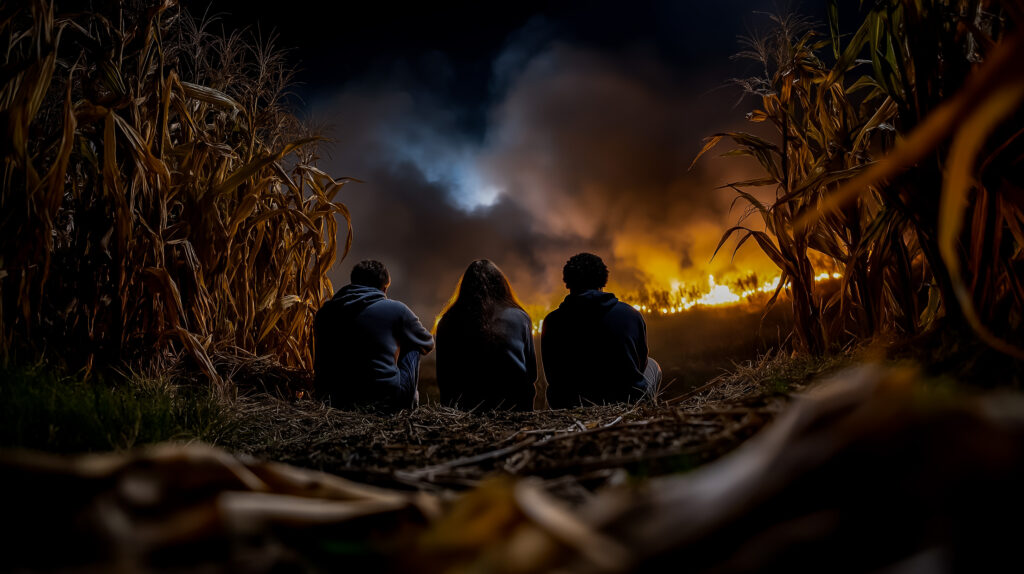Boy Watches Burning Village, Sunset – A Tragic Contrast of Beauty and Destruction
As the sun begins its slow descent beyond the horizon, painting the sky with strokes of orange, red, and gold, a haunting scene is revealed. A boy stands still, his silhouette outlined by fire and fading light. The quiet stillness of the sunset is violently pierced by the crackle of flames devouring rooftops. What is seen is not a landscape of peace—but of despair. A boy watches a burning village at sunset, and the world bears witness to a tragedy too often ignored.
This image, both poetic and devastating, has been increasingly used to illustrate the ongoing consequences of global conflict. The juxtaposition of natural beauty with human suffering forces a reflection: how has such innocence been placed at the heart of destruction?
When the Sunset Becomes a Stage for Sorrow
It must be noted that sunsets are usually associated with calm endings. Yet in this context, the sunset serves as a cruel backdrop. Behind the glow of twilight, homes are being consumed. Livelihoods are being erased. Entire communities are being silenced. The contrast could not be more severe.
The boy’s stance—motionless and helpless—conveys more than fear; it expresses the paralyzing weight of loss. He is not alone in his suffering, but he is alone in the frame. In that moment, the boy watching the burning village becomes a universal symbol of displaced youth and broken childhoods.
Moreover, the tragedy is not only about what has been destroyed. It is also about what the boy is forced to witness. His gaze, fixed on the inferno, captures a thousand untold stories. Perhaps his family had lived there for generations. Perhaps friends and neighbors had shared meals and laughter within those very walls. All of it is now being erased—consumed by flame and time.
The Silent Cry of Children in Conflict Zones
All around the world, scenes like this are being captured and circulated—yet their message is often softened by distance. However, when a child is shown in direct confrontation with destruction, that distance is closed. The viewer is compelled to feel, not just observe.
It has been widely documented that children in war-torn regions suffer most deeply. Not only are they exposed to physical dangers, but their psychological scars are more profound and enduring. In this particular scenario, the burning village at sunset becomes more than a physical loss—it becomes a symbol of stolen innocence.
Additionally, the timing of the event—during sunset—adds emotional weight. The symbolism is heavy: as the sun sets, so does the boy’s sense of safety, of home, of childhood. Nothing will ever be the same once night falls.
The Burning Village: A Metaphor for Forgotten Lives
Unfortunately, what is being shown here is not rare. Villages continue to be burned in conflict zones across the globe. Civilian lives are routinely displaced, and youth are thrust into roles they never chose. Homes are destroyed, but identities are also dismantled.
The village fire at sunset, in this case, may not be named on maps. But in this single moment, it speaks for countless unnamed places where lives have been upended. Through this one boy, thousands of other children are represented—each one robbed of their future by circumstances beyond their control.
Meanwhile, the aesthetic beauty of the sunset makes the scene even more disturbing. The world is reminded that nature continues regardless of human suffering. The sun sets, birds fly, and the wind blows—even as homes are turned to ash. It’s this harsh contrast that forces the viewer to think more deeply.
Hope Seen Through Smoke and Silence
And yet, not all is lost. In the stillness of the moment, there is a spark of strength. The boy, though small and still, is not broken. His very presence is a form of defiance. He stands and watches—not to surrender—but perhaps to remember. To witness. To survive.
While sunset and destruction share the same canvas, so too do pain and perseverance. Human history has repeatedly shown that even from ashes, life can be rebuilt. Communities can be restored. Scars may remain, but healing can begin.
That said, global awareness must be raised. Conflict zones must not remain faceless. Children like this boy must not be forgotten. Action must be taken—not just through aid and policy, but through compassion, storytelling, and visibility. For when the world truly sees what is happening, change can follow.
Conclusion: The Fire, The Boy, The Sunset
In conclusion, the image of a boy watching a burning village at sunset is more than just a photograph. It is a narrative of grief, survival, and reflection. As the fire rages and the sun sinks, a deeper truth is revealed—one that should not be ignored.
It is a story that must be told repeatedly until it no longer needs to be.


